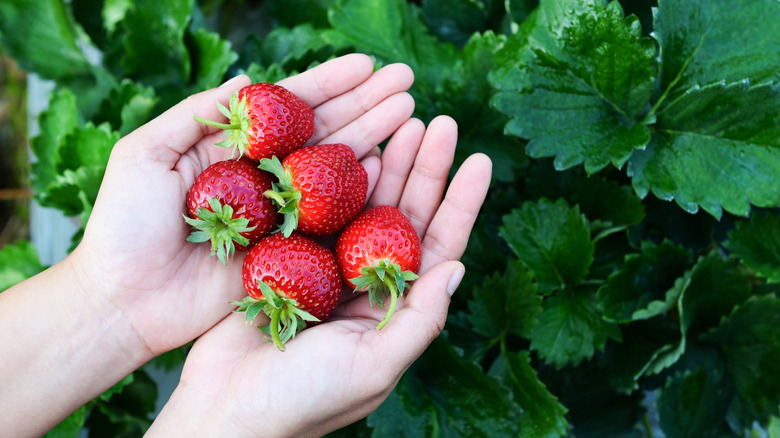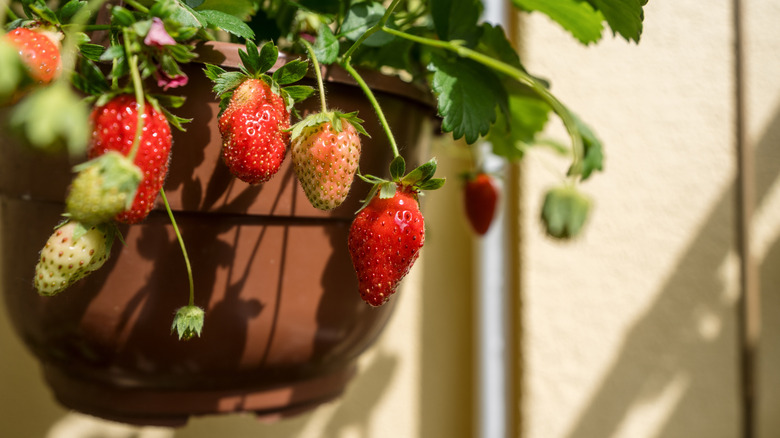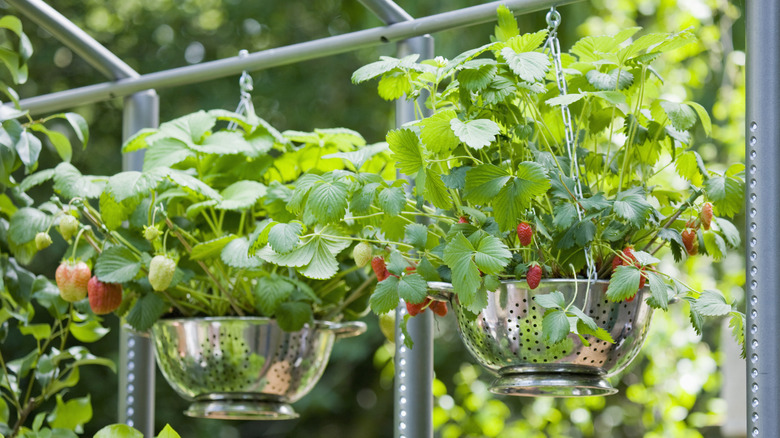How To Grow Strawberries If You Don't Have Space For A Garden Bed
Nothing says spring like the first bite of a fresh strawberry straight from the garden. With many varieties available, you can enjoy these berries across a wide range of climates and USDA growing zones. However, if you're planning to grow strawberries, it can be difficult to set up a flourishing garden in a small space — particularly if you don't have anywhere to build a garden bed.
When you don't have much surface area to work with, the key is to grow vertically instead. One effective way to grow strawberries without a garden bed is to use hanging planters. Apart from circumventing the space constraints, growing them in hanging planters rather than in the ground helps you avoid one other common pitfall: slugs munching on your strawberries before you get a chance to pick them.
"I always battle slugs in my garden, so growing strawberries in hanging planters is perhaps the ideal method for this crop in that situation," shares Tiffany Selvey, House Digest's Garden Editor and in-house Master Gardener, in an exclusive interview with House Digest. "Getting plants off the ground where slugs and snails do their damage can greatly reduce the number of berries you lose."
How to grow strawberries in hanging planters
Any relatively shallow and well-draining pot will work for growing strawberries, which are shallow-rooted. Use an all-purpose potting mix and set the young plants in place with the crowns just above the surface of the soil. If you're placing multiple plants in one container, place them about 8 to 10 inches apart.
According to Selvey, strawberries need lots of sunshine in order to produce plenty of juicy, sweet fruits. Full sun means at least six hours of direct sun per day. Selvey recommends using a plant or bird feeder pole if necessary to help your plants thrive with a sufficient amount of sunlight — you'll end up with happier and healthier strawberries.
Hanging planters aren't just for avoiding slugs. They have aesthetic appeal, too. "Hanging planters filled with strawberry plants are also pretty! They produce delicate little white blooms followed by cascades of ripe fruit — if you're lucky," Selvey exclusively tells House Digest.
Challenges of growing strawberries in hanging planters
Selvey says that strawberries (and other plants) need a bit of special care when grown in containers rather than in garden beds. They lose nutrients faster compared to plants grown in the ground, so you have to fertilize regularly. "Plan on fertilizing about every three weeks to make sure your strawberries have all the nutrients they need to bloom and produce ripe fruit," she tells House Digest exclusively. Use a fertilizer with a balanced ratio of nutrients, or one that's a bit higher in potassium to encourage flowers and fruits.
Similarly, container-grown plants dry out quickly. Strawberries, in particular, need soil that remains consistently moist, according to Selvey. So, you may find yourself watering more frequently to prevent the plants from struggling with a lack of water. One option for hotter climates is to plant them in plastic pots rather than in ones made from terracotta. Since plastic is not porous like clay, it can keep your plants hydrated for longer.


